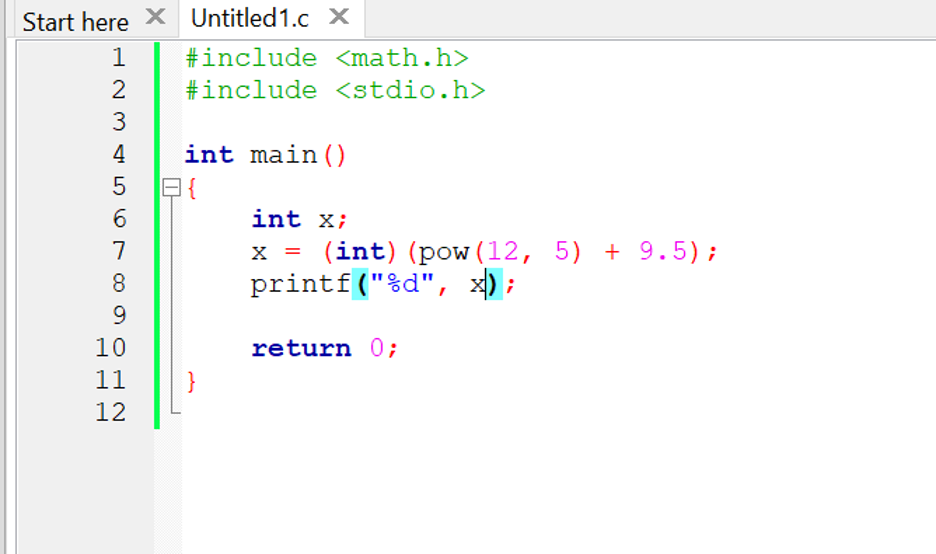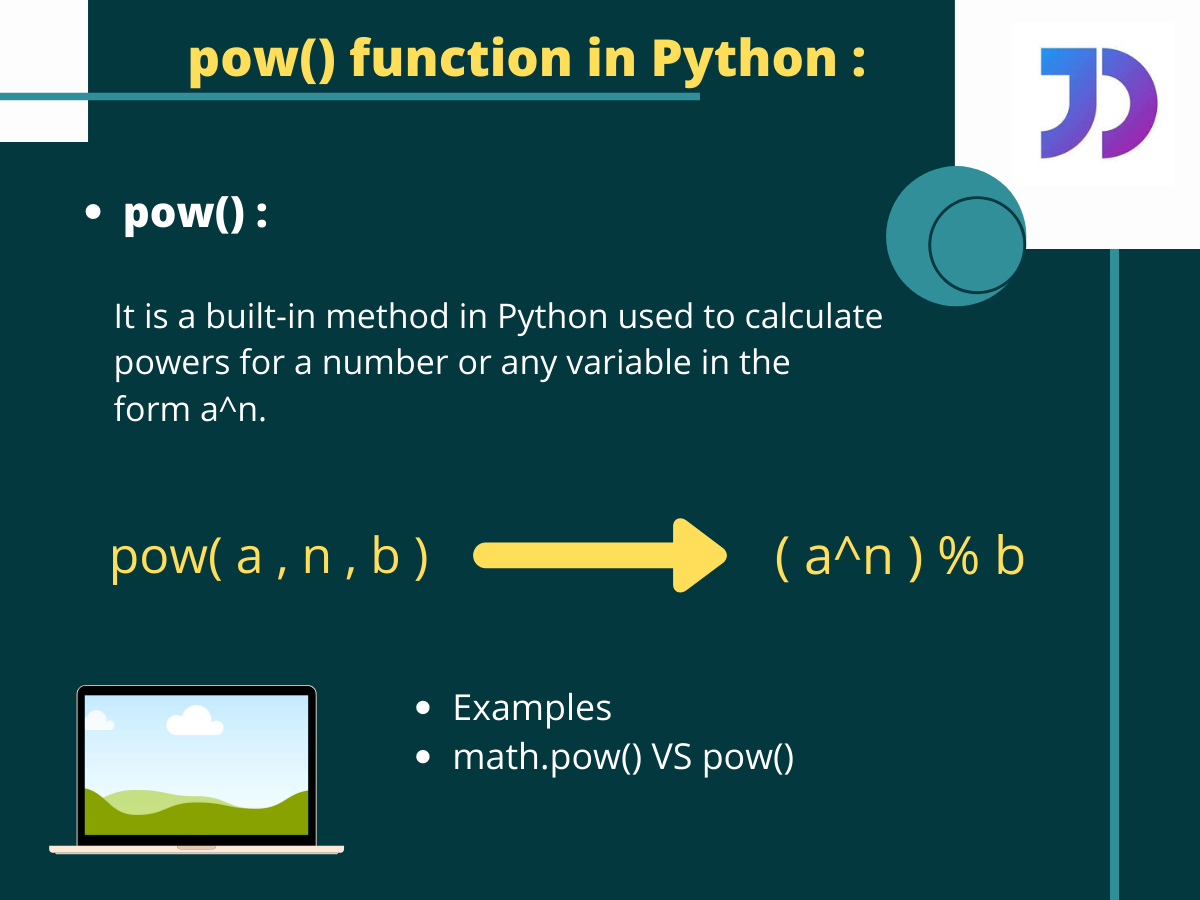C Math Pow
C Math Pow - The pow() function is defined in the <math.h> header file. The pow() function raises a number to the power of another number. Given two numbers base and exponent, the c++ or c pow() function finds x raised to the power of y i.e. For example, [mathematics] x y = pow(x, y) [in programming]. The c standard (n1548 §7.12.7.4) has this to say about pow: A domain error occurs if x is finite and negative and y is finite and not an integer value. The c library pow() function of type double accepts the parameter x and y that simplifies the x raised to the power of y. This function allows programmers to calculate a base number raised. So, according to the c standard,. Basically in c/c++, the exponent value is calculated using the.
Given two numbers base and exponent, the c++ or c pow() function finds x raised to the power of y i.e. For example, [mathematics] x y = pow(x, y) [in programming]. So, according to the c standard,. A domain error occurs if x is finite and negative and y is finite and not an integer value. This function allows programmers to calculate a base number raised. The pow() function is defined in the <math.h> header file. The c standard (n1548 §7.12.7.4) has this to say about pow: The pow() function raises a number to the power of another number. Basically in c/c++, the exponent value is calculated using the. The c library pow() function of type double accepts the parameter x and y that simplifies the x raised to the power of y.
This function allows programmers to calculate a base number raised. So, according to the c standard,. Given two numbers base and exponent, the c++ or c pow() function finds x raised to the power of y i.e. The c standard (n1548 §7.12.7.4) has this to say about pow: A domain error occurs if x is finite and negative and y is finite and not an integer value. The c library pow() function of type double accepts the parameter x and y that simplifies the x raised to the power of y. The pow() function takes two arguments (base value and power value) and, returns the power raised to the base number. The pow() function raises a number to the power of another number. Basically in c/c++, the exponent value is calculated using the. For example, [mathematics] x y = pow(x, y) [in programming].
pow Math function in C Programming Language Video Tutorial YouTube
The pow() function takes two arguments (base value and power value) and, returns the power raised to the base number. The c library pow() function of type double accepts the parameter x and y that simplifies the x raised to the power of y. So, according to the c standard,. Basically in c/c++, the exponent value is calculated using the..
Pow Function in C
Basically in c/c++, the exponent value is calculated using the. The pow() function is defined in the <math.h> header file. This function allows programmers to calculate a base number raised. For example, [mathematics] x y = pow(x, y) [in programming]. Given two numbers base and exponent, the c++ or c pow() function finds x raised to the power of y.
C Tutorial C Math Pow
Basically in c/c++, the exponent value is calculated using the. The c standard (n1548 §7.12.7.4) has this to say about pow: For example, [mathematics] x y = pow(x, y) [in programming]. The pow() function is defined in the <math.h> header file. The pow() function takes two arguments (base value and power value) and, returns the power raised to the base.
C Programming Tutorial 10 The pow() Function YouTube
For example, [mathematics] x y = pow(x, y) [in programming]. The pow() function raises a number to the power of another number. The c standard (n1548 §7.12.7.4) has this to say about pow: Given two numbers base and exponent, the c++ or c pow() function finds x raised to the power of y i.e. The pow() function takes two arguments.
math.h in c++ pow function YouTube
This function allows programmers to calculate a base number raised. So, according to the c standard,. The c library pow() function of type double accepts the parameter x and y that simplifies the x raised to the power of y. For example, [mathematics] x y = pow(x, y) [in programming]. Basically in c/c++, the exponent value is calculated using the.
Python pow() method AskPython
The c standard (n1548 §7.12.7.4) has this to say about pow: Basically in c/c++, the exponent value is calculated using the. For example, [mathematics] x y = pow(x, y) [in programming]. This function allows programmers to calculate a base number raised. The pow() function is defined in the <math.h> header file.
今日打开第一题小题大做了CSDN社区
The c library pow() function of type double accepts the parameter x and y that simplifies the x raised to the power of y. Basically in c/c++, the exponent value is calculated using the. For example, [mathematics] x y = pow(x, y) [in programming]. The pow() function is defined in the <math.h> header file. Given two numbers base and exponent,.
pow() function C Programming Tutorial YouTube
The c standard (n1548 §7.12.7.4) has this to say about pow: This function allows programmers to calculate a base number raised. Basically in c/c++, the exponent value is calculated using the. The pow() function raises a number to the power of another number. For example, [mathematics] x y = pow(x, y) [in programming].
Java Math.pow函数。完整指南Math.pow() 用于计算一个数字上升到另一个数字的幂。pow()方法在考虑 掘金
Basically in c/c++, the exponent value is calculated using the. This function allows programmers to calculate a base number raised. The pow() function is defined in the <math.h> header file. The c library pow() function of type double accepts the parameter x and y that simplifies the x raised to the power of y. For example, [mathematics] x y =.
POW FUNCTION C++ YouTube
This function allows programmers to calculate a base number raised. So, according to the c standard,. The c standard (n1548 §7.12.7.4) has this to say about pow: A domain error occurs if x is finite and negative and y is finite and not an integer value. The pow() function takes two arguments (base value and power value) and, returns the.
Basically In C/C++, The Exponent Value Is Calculated Using The.
So, according to the c standard,. For example, [mathematics] x y = pow(x, y) [in programming]. The pow() function is defined in the <math.h> header file. The pow() function raises a number to the power of another number.
The C Library Pow() Function Of Type Double Accepts The Parameter X And Y That Simplifies The X Raised To The Power Of Y.
The c standard (n1548 §7.12.7.4) has this to say about pow: The pow() function takes two arguments (base value and power value) and, returns the power raised to the base number. Given two numbers base and exponent, the c++ or c pow() function finds x raised to the power of y i.e. A domain error occurs if x is finite and negative and y is finite and not an integer value.







